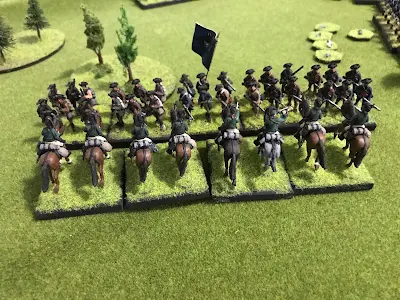Thursday, August 13, 2020
Return to the Crimean War
Tuesday, August 11, 2020
"Regimental Standards of William Health's Brigade of Continental Foot, 1776"
One of the joys of the lifting of restrictions during this time of sickness is the reopening of libraries. Once again I can pester the inter library loan desk to look up unusual books for me or get me long forgotten articles. At present I am doing research on regimental colors of the Continental line during the American Revolution. In a series of postings I will be posting some of my finds here. I hope this spreading of information will be If service I my fellow Rev War gamers and buffs.
The information is from the Massachusetts Historical Society who have the William Heath papers. This concerns his brigade in April/May 1776 and provides some interesting information concerning facing colors and standards for the Continental line regiments in his brigade.
"Two standards for each regiment and four colours to each regiment for the Grand Divisions, the First Standard to be the Union throughout. The Second to be the colour of the facings of the regiment with the following motto.
7th Regiment Col. Wm. Prescott, red, white field, black thorn bush, flesh coloured hand extended to pluck it up, motto: "He that touches one shall prick his fingers."
16th Regiment Col. Paul Dudley Sargent, red, white field.
18th Regiment Col. Edmund Phinney, black (crossed out) buff.
24th Regiment Col. John Greaton, buff, red field, white thorn bush, flesh coloured hand extended to pluck it, motto: the same as the 7th Regiment.
26th Regiment Loami Baldwin Colonel, straw color. "
So, what might this flag have looked like? I have used this image of one of the Gostelowe flags as an example. The center device is very similar to that description turn The 7th and 24th Regiments. This flag, and others from the Gostelowe flag series are available from" League of Augusberg" at a very reasonable price. These are highly useful and very colorful. I have used a number of them in my 1776 regiments.
https://www.leagueofaugsburg.com/shop/products-subcat-37.html
Bibliography:
Zlatich, Marko. " Regimental Standards of William Heath's Brigade of Continental Foot, 1776"
Military Collector and Historian, 33 (Winter 1981), pp. 174-175.
Also:
Papers of William Heath
Vol. 6 folio 245
Massachusetts Historical Society.
Friday, August 7, 2020
Fighting Hobkirk's Hill
The Virginia Brigade and Loyalists continue to blaze away at each other.
 |
| Add caption |
Setting the Stage
American Order of Battle:
General Nathaniel Greene commanding
Reserve:
Continental Artillery (2 x 6#'s)
North Carolina Militia battalion (30)
North Carolina Rifle men (12)
Washington's Dragoons (10)
Main Line:
Maryland Brigade: Col. Otho Williams
1st Maryland. (30)
2nd Maryland. (30)
Virginia Brigade: Col. Isaac Huger
1st Virginia. (30)
2nd Virginia (30)
Skirmishers Line: Capt. Kirkwood
Delaware Light Infantry company (18)
Maryland & Virginia light infantry companies (18)
British Order of Battle
Lord Rawdon commanding
Main line: Lt.Col. Campbell
Rifles and volunteer light infantry (18)
63rd Regiment of Foot (30)
King's American Regiment (30)
New York Volunteers (30)
Reserve: Major Campbell
Royal Artillery (6#)
Coffin's Dragoons (8)
South Carolina Royalists (30)
Volunteers of Ireland (30)









































